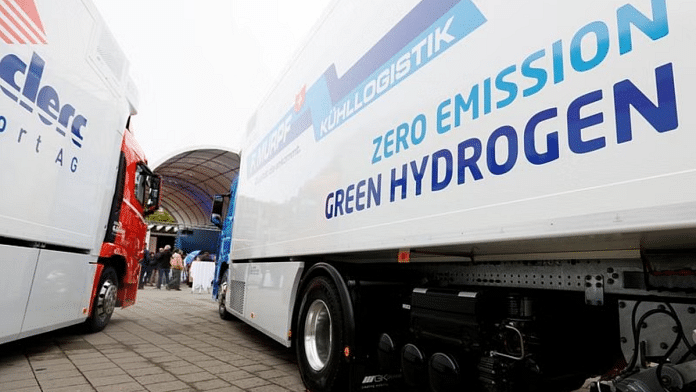The role of artificial intelligence in the optimisation of energy transition and production of green hydrogen is likely to be the buzz in the run-up to COP28 in Dubai and the 10th Vibrant Gujarat Global Summit. Green hydrogen is considered environmentally friendly because its production does not generate carbon emissions. This makes it a key element in efforts to decarbonise various sectors of the economy, particularly in industries where direct electrification is challenging.
However, India faces several challenges in the quest to achieve its energy transition goals. There are apprehensions over resilience, scaling, and return on investments, all of which should be addressed at the COP28 meet, along with the myriad ways in which AI could provide solutions at scale.
India’s ambitious goals
India will need approximately 115 GW of renewable power and around 50 billion litres of freshwater to meet the National Green Hydrogen Mission’s (NGHM) target of producing 5 million metric tonnes per annum of green hydrogen by 2030, according to the 2022 EY India-SED Fund report.
This would necessitate active participation in public policy consultations and the utilisation of AI-powered forecasting techniques to meticulously assess both best and worst-case scenarios. The application of AI empowers stakeholders to augment their comprehension of the potential impacts, trade offs, and benefits inherent in the prioritisation of green hydrogen production. Some crucial use cases of AI in green hydrogen space have been explored below.
Also read: Ethanol blending for cars is ignoring food security in India. Go for green hydrogen…
Propelling the local manufacturing ecosystem
India faces challenges in expanding the production of electrolysers at a faster rate and introducing new ideas into current manufacturing methods. Using AI algorithms and smart data analysis, along with a software-focused automation system based on the IEC61499 standard (for interoperability and portability), could help streamline complicated production processes.
This technology can predict and manage factors like temperature and pressure, making the manufacturing process more efficient, safer, better, and cost-effective, and speed up bringing products to market.
Identifying efficient catalysts
In India, using biomass for green hydrogen production is allowed. However, this process generates carbon emissions, says a study by environmental and energy think-tank, Climate Risk Horizons. To address this, policymakers need to speed up the adoption of carbon capture, utilisation, and storage (CCUS) for decarbonisation.
According to NGHM, biomass-based green hydrogen is in the pilot stage and faces challenges in biomass collection and scaling. NGHM aims to reduce biomass collection costs and the capital cost of converting biomass to hydrogen. However, a report by Emkay Global lists the challenges and lack of visibility on desirable levels of green hydrogen yield. The report suggests that the production of biomass-based green hydrogen seems unlikely to reach a meaningful scale till 2030.
To approach efficient production from another angle, researchers at the ANU College of Engineering, Computing & Cybernetics, Australia, are using AI for simulated experiments to optimise the catalytic reaction for green hydrogen production. Currently, the most effective catalysts are made of rare and expensive metals, which are hard to obtain. AI could predict the behaviour of different materials and hence help India identify efficient catalysts for a new generation of green hydrogen production methods.
Also read: How Modi govt’s Hydrogen push will be driven by the auto sector
Reassessing government incentives
A report by The Energy and Resources Institute (TERI) and the Energy Transitions Commission emphasises that hydrogen production from renewables is energy-intensive and direct electrification is more efficient. For example, converting 15 units of electricity to hydrogen results in only 12 usable units, with an additional loss during compression and transportation.
Despite this, the Indian government offers incentives, such as waiving inter-state transmission charges, to hydrogen producers under NGHM. AI can help reassess these incentives based on energy sources, emission exposure, and net-zero targets. It can also predict energy demand patterns and detect faults in hydrogen production processes.
In South Korea, researchers at the Ulsan Institute of Science and Technology have developed an AI-based predictive model for hydrogen production, considering technical performance, production costs, and carbon dioxide emissions. India could benefit from adopting similar AI models.
Storage and distribution of green hydrogen
AI can be used to develop and monitor storage solutions for green hydrogen, which can be challenging due to the gas’ low boiling point and flammability. AI-powered systems can track storage conditions, detect leaks, and predict maintenance needs. The technology can also be used to create a network of green hydrogen fuelling stations, optimising their location and capacity based on demand patterns and real-time data.
Addressing the black box concern
Innovation sandboxes would have a symbiotic relationship with AI. On the one hand, AI, data intelligence, and machine learning could help inform sandboxes to boost innovation in the energy transition space. On the other, the sandbox could also provide a safe zone to address and tackle critical concerns over the black box issue surrounding AI algorithms. Since India doesn’t have a comprehensive law in place for AI, a sandbox could help regulators assess challenges and maximise efficiency from a place of advantage.
Way forward
India’s aspiration to emerge as a leading hub for green hydrogen necessitates the establishment of a resilient policy framework, underscored by the strategic integration of AI. The utilisation of AI equips policymakers with data-driven insights, enabling informed decision-making to optimise the production and utilisation of green hydrogen. This sophisticated approach not only fortifies the groundwork for the sector’s expansion but also catalyses timely and effective collaboration among industry stakeholders. The intersection of AI and policymaking would position India at the forefront of technological advancements in sustainable energy, fostering a conducive environment for the growth of the green hydrogen industry.
Swati is Manager, Public Policy at Chase India and Manash is MD and Co-Founder, Chase APAC. Views are personal.
(Edited by Humra Laeeq)



